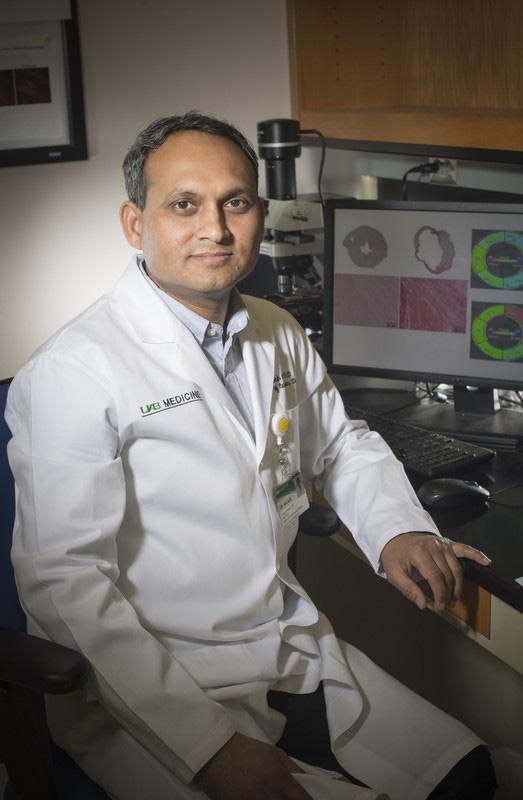A mouse-model study of the sensor will aid the search for treatments to delay human heart failure, which often follows a heart attack.

Credit: UAB
BIRMINGHAM, Ala. – After heart attack injury, several fatty-acid-derived bioactive molecules — including one called resolvin D1 — play an essential signaling role to safely clear inflammation and help repair heart muscle. The mechanism of how this resolution occurs is not well-understood.
There is a receptor on the surface of many immune cells called ALX/FRP2, and in models of atherosclerosis, ALX/FPR2 is known to act as a sensor to help resolve inflammation.
In a 2015 study using a mouse model, University of Alabama at Birmingham researcher Ganesh Halade, Ph.D., observed that, after heart attack injury, ALX/FPR2 was highly expressed in immune myeloid cells and was activated by resolvin D1 in immune cells in the spleen and in immune cells at the heart attack site. The result was an expedited resolution of the heart attack injury. Resolvin D1 is one of the omega 3 fatty-acid metabolites known as specialized pro-resolving mediators, or SPMs, that help clear inflammation.
Now, Halade and colleagues at UAB, Boston and France have used mice that completely lack ALX/FPR2 to learn more about the pathways this resolution sensor uses to target inflammation. Such knowledge will help in finding treatments to delay the human heart failure that often follows a heart attack.
Before beginning the mouse studies, Halade and colleagues examined heart muscle tissue from patients with heart failure. They found that ALX/FPR2 was plentiful in these human ischemic hearts, and it was located in the cytoplasm of the myocardium cells. In contrast, in healthy human heart tissue, ALX/FPR2 was limited to the cell membrane. To learn more, they then expanded study of the precise and comprehensive role of the resolution receptor using mice having an ALX/FPR2 gene deletion.
The researchers found that mice lacking ALX/FPR2 showed spontaneous, age-related obesity. With the obesity, the ALX/FPR2-null mice developed heart disease that weakened the heart’s ability to pump blood, and they had a shortened lifespan with aging. The aging mice also developed kidney inflammation, as shown by increased inflammation markers like NGAL, TNF-alpha and CCL2, and elevated plasma creatinine levels.
After a heart attack in normal mice, leukocyte immune cells in the spleen produce SPMs. However, in the ALX/FPR2-null mice, the researchers found lower levels of SPMs in the heart and the spleen after heart attack, indicative of non-resolving inflammation. Halade says this suggested impaired cross-talk between the injured heart and splenic leukocytes, a cross-talk that is required for the resolution of inflammation. In addition to the lower levels of SPMs, the ALX/FPR2-null mice showed dysregulation of several immune responsive enzymes — lower levels of LOX enzymes and increased levels of the pro-inflammatory COX-1 and COX-2 enzymes.
Finally, the ALX/FPR2-null mice showed impairment of activated macrophage cells to phagocytose — that is, to “eat” infecting microbes or dead human cells, one of the macrophage’s prime functions. After heart attack, the ALX/FPR2-null mice had increased numbers of neutrophils, the first phagocytic responders after heart injury, in both the spleen and the left ventricle of the heart. Also, there were reduced numbers of reparative macrophages in both the spleen and the heart.
Altogether, says Halade, an associate professor in the UAB Department of Medicine Division of Cardiovascular Disease, these findings demonstrate the integrative role of ALX/FPR2 as a primary target to manage cardiometabolic health, inflammation-resolution processes and cardiorenal syndrome in aging.
###
Co-authors with Halade of the study published in Molecular Metabolism, “Lack of resolution sensor drives age-related cardiometabolic and cardiorenal defects and impedes inflammation-resolution in heart failure,” are Bochra Tourki, Vasundhara Kain, Amanda B. Pullen, Nirav Patel and Pankaj Arora, Division of Cardiovascular Disease, UAB Department of Medicine; Paul C. Norris and Charles N. Serhan, Harvard Medical School; and Xavier Leroy, Domain Therapeutics, Steinsoultz, Alsace, France.
Support came from National Institutes of Health grants HL132989 and HL144788, and American Heart Association postdoctoral fellowship POST31000008.
Media Contact
Jeff Hansen
[email protected]
205-209-2355
Original Source
https:/
Related Journal Article
http://dx.




